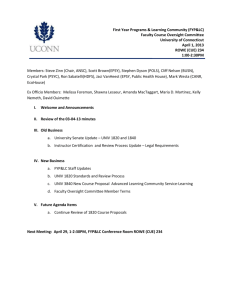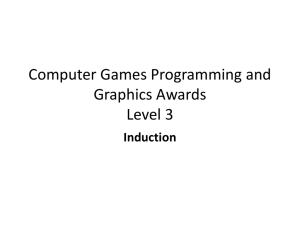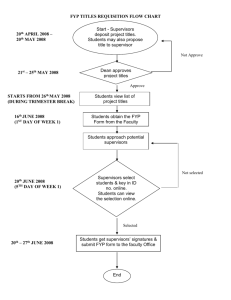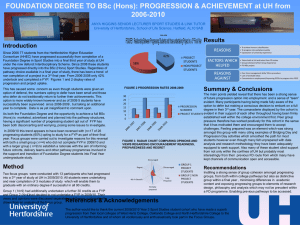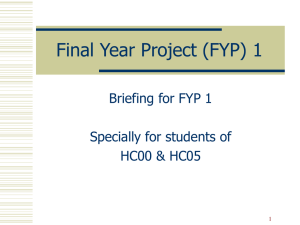Best Practices for Final Year Projects Software Engineering City University of Hong Kong
advertisement
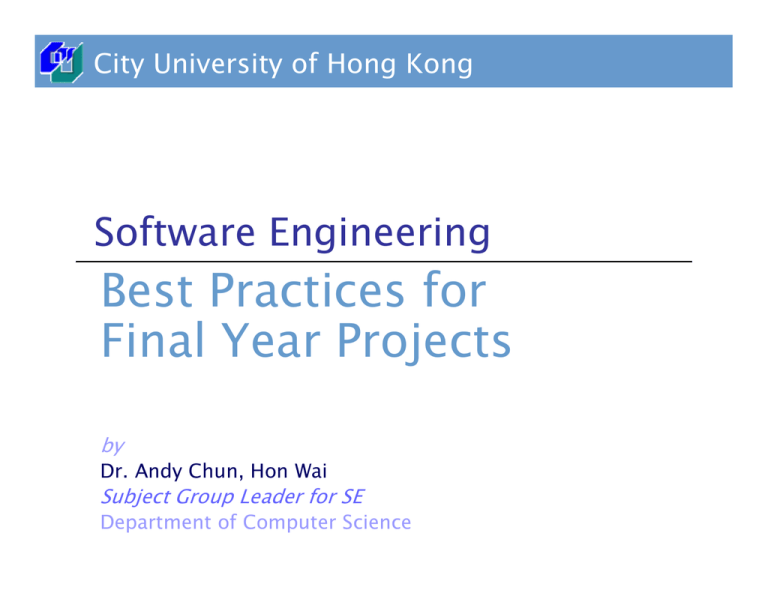
City University of Hong Kong Software Engineering Best Practices for Final Year Projects by Dr. Andy Chun, Hon Wai Subject Group Leader for SE Department of Computer Science Content ` FYP Lifecycle Software Engineering – Best Practices for FYP Copyright © Chun, Hon Wai 2004-2005 2 Content ` 1. 2. 3. 4. Agile Principles Talk to Your Advisor Work with Your Advisor Software Must Work Manage Changes Software Engineering – Best Practices for FYP Copyright © Chun, Hon Wai 2004-2005 3 Content ` FYP Best Practices 5. Be an Expert 6. Manage Project Scope 7. Develop Iteratively 8. Test Your Software 9. Learn to Manage Yourself 10. Practice Makes Perfect Software Engineering – Best Practices for FYP Copyright © Chun, Hon Wai 2004-2005 4 Remember! ` Your FYP is the single most important project in your whole undergraduate life! Software Engineering – Best Practices for FYP Copyright © Chun, Hon Wai 2004-2005 5 FYP Lifecycle Phases Process Workflows Inception Elaboration Construction Transition Business Modeling Requirements Analysis & Design Implementation Test Deployment Supporting Workflows Configuration Mgmt Project Management Environment Preliminary Iteration(s) Iter. #1 Iter. #2 Iter. #n Iter. Iter. #n+1 #n+2 Iter. #m Iter. #m+1 Iterations Software Engineering – Best Practices for FYP Copyright © Chun, Hon Wai 2004-2005 6 4 Key Phases 1. 2. 3. 4. Inception Phase Elaboration Phase Construction Phase Transition Phase Software Engineering – Best Practices for FYP Copyright © Chun, Hon Wai 2004-2005 7 Inception Phase (Sept) ` Tasks: ` Finalize FYP with advisor ` Do some basic reading to help decide ` Set goals and objectives for yourself ` Objectives: ` Common understanding between you and advisor on scope of work ` Deliverables: ` “Project Plan” - a detailed proposal with project schedule Software Engineering – Best Practices for FYP Copyright © Chun, Hon Wai 2004-2005 8 Elaboration Phase (Oct-Nov) ` Tasks: ` Perform background research ` Define system requirements ` Based on research, design your system ` Objectives: ` Detailed design based on solid research ` Deliverables (may need 2 iterations): ` “Interim Report” (10%) - background research and initial design Software Engineering – Best Practices for FYP Copyright © Chun, Hon Wai 2004-2005 9 Construction Phase (Dec-Mar) ` Tasks: ` Coding and testing ` Experimentation and Analysis ` Demonstrate prototype to advisor for feedback ` Objectives: ` Finish software development ` Deliverables (may need 2 iterations): ` Source code with documentations ` Demonstration to advisor and assessor Software Engineering – Best Practices for FYP Copyright © Chun, Hon Wai 2004-2005 10 Transition Phase (Mar-Apr) ` Tasks: ` Document work as Final Report ` Prepare for presentation ` Objectives: ` Wrap up and present project ` Deliverables: ` “Final Report” (30%) ` Source code ` “Project Presentation” (10%) Software Engineering – Best Practices for FYP Copyright © Chun, Hon Wai 2004-2005 11 10 FYP Best Practices ` My own personal observations for the past 10 years at CityU ` Note: ` This is only my own personal opinion ` Follow your supervisor’s guidelines first Software Engineering – Best Practices for FYP Copyright © Chun, Hon Wai 2004-2005 12 Talk to Your Advisor Software Engineering – Best Practices for FYP Copyright © Chun, Hon Wai 2004-2005 13 Notes: ` Report what you are doing at least once a month ` Preferably once every 2 weeks ` Tell advisor: ` What papers you have read ` What you have learned ` Your design/coding progress Software Engineering – Best Practices for FYP Copyright © Chun, Hon Wai 2004-2005 14 Software Engineering Principles: ` Agile Manifesto: ` Individuals and interactions over processes and tools ` XP Value: ` Communication Software Engineering – Best Practices for FYP Copyright © Chun, Hon Wai 2004-2005 15 Work with Your Advisor Software Engineering – Best Practices for FYP Copyright © Chun, Hon Wai 2004-2005 16 Notes: ` Discuss problems with your advisor ` Seek guidance and verification on project direction ` Give advisor drafts of all deliverables for feedback ` Understand advisor expectations ` Understand minimum requirement for a “pass” ` Understand what makes an “A” project Software Engineering – Best Practices for FYP Copyright © Chun, Hon Wai 2004-2005 17 Software Engineering Principles: ` Agile Manifesto: ` Customer collaboration over contract negotiation ` XP Values: ` Feedback ` Courage Software Engineering – Best Practices for FYP Copyright © Chun, Hon Wai 2004-2005 18 Software Must Work Software Engineering – Best Practices for FYP Copyright © Chun, Hon Wai 2004-2005 19 Notes: ` Make sure your scope is not too large ` Divide your project into stages ` At least the first stage must work ` Have a prototype working by end of Semester A to be safe Software Engineering – Best Practices for FYP Copyright © Chun, Hon Wai 2004-2005 20 Software Engineering Principles: ` Agile Manifesto: ` Working software over comprehensive documentation Software Engineering – Best Practices for FYP Copyright © Chun, Hon Wai 2004-2005 21 Manage Changes Software Engineering – Best Practices for FYP Copyright © Chun, Hon Wai 2004-2005 22 Notes: ` Changes are unavoidable for any project ` Learn how to control change ` But make sure changes do not impact schedule ` If so, reduce or modify scope if needed ` FYP title can be changed any time ` Need to have prototype working asap to know if heading towards a dead-end Software Engineering – Best Practices for FYP Copyright © Chun, Hon Wai 2004-2005 23 Software Engineering Principles: ` Agile Manifesto: ` Responding to change over following a plan ` RUP Best Practice: ` Control changes to software Software Engineering – Best Practices for FYP Copyright © Chun, Hon Wai 2004-2005 24 Be an Expert Software Engineering – Best Practices for FYP Copyright © Chun, Hon Wai 2004-2005 25 Notes: ` FYP is an opportunity for you to demonstrate you can learn on your own ` Show what you have learned by being an expert on your FYP topic ` Know ` Know ` Know ` Know what current state-of-the-art all players: researchers/products current technology direction success stories ` Technical merit is 40% of FYP Software Engineering – Best Practices for FYP Copyright © Chun, Hon Wai 2004-2005 26 Manage Project Scope Software Engineering – Best Practices for FYP Copyright © Chun, Hon Wai 2004-2005 27 Notes: ` Must have a checklist of requirements ` Prioritize this list ` Estimate effort/time for each item ` Verify all requirements can be done within schedule Software Engineering – Best Practices for FYP Copyright © Chun, Hon Wai 2004-2005 28 Software Engineering Principles: ` RUP Best Practices: ` Manage requirements ` XP Best Practices: ` Planning Game Software Engineering – Best Practices for FYP Copyright © Chun, Hon Wai 2004-2005 29 Develop Iteratively Software Engineering – Best Practices for FYP Copyright © Chun, Hon Wai 2004-2005 30 Notes: ` You should have at least 2 or 3 iterations ` Iteration 1 is prototype – used to get feedback from advisor ` Iteration 2 is normal FYP deliverable ` Iteration 3 is enhanced FYP for “A” student Software Engineering – Best Practices for FYP Copyright © Chun, Hon Wai 2004-2005 31 Software Engineering Principles: ` RUP Best Practices: ` Develop software iteratively ` XP Best Practices: ` Small Releases Software Engineering – Best Practices for FYP Copyright © Chun, Hon Wai 2004-2005 32 Test Your Software Software Engineering – Best Practices for FYP Copyright © Chun, Hon Wai 2004-2005 33 Notes: ` Must have at least unit test cases ` Use *Unit ` Use Log4* ` Do benchmarking and comparisons ` Must be able to compare: ` Compare your results with results from other approaches for same or similar problems Software Engineering – Best Practices for FYP Copyright © Chun, Hon Wai 2004-2005 34 Software Engineering Principles: ` RUP Best Practices: ` Verify Software Quality ` XP Best Practices: ` Test-driven Software Engineering – Best Practices for FYP Copyright © Chun, Hon Wai 2004-2005 35 Learn to Manage Yourself Software Engineering – Best Practices for FYP Copyright © Chun, Hon Wai 2004-2005 36 Notes: ` Manage your time ` FYP is equivalent of 2 courses per semester ` Your have only 13 + 9 weeks to do FYP ` We expect you to put in roughly 300 hours total ` Roughly 2 days/week (14 hours) ` Write down what you have done each week Software Engineering – Best Practices for FYP Copyright © Chun, Hon Wai 2004-2005 37 Notes: ` Keep track of: ` Time spent each week ` Pages of document written each week ` LOC written each week ` Bugs found each week ` Requirements satisfied each week ` Compare with original schedule ` Project management skills count 10% of FYP Software Engineering – Best Practices for FYP Copyright © Chun, Hon Wai 2004-2005 38 Software Engineering Principles: ` Personal Software Process (PSP) ` From the CMM folks Software Engineering – Best Practices for FYP Copyright © Chun, Hon Wai 2004-2005 39 Practice Makes Perfect Software Engineering – Best Practices for FYP Copyright © Chun, Hon Wai 2004-2005 40 Notes: ` Make sure you practice your presentation beforehand ` Give advisor a copy of PPT at least 1 week before to get feedback ` Dry run in front of friends/classmates Software Engineering – Best Practices for FYP Copyright © Chun, Hon Wai 2004-2005 41 References: ` Agile Manifesto ` agilemanifesto.org ` RUP ` ibm.com/developerworks/rational/library/253.html ` XP ` extremeprogramming.org ` PSP ` www.sei.cmu.edu/tsp/psp.html Software Engineering – Best Practices for FYP Copyright © Chun, Hon Wai 2004-2005 42 Most Important Best Practice Remember to Have Fun Software Engineering – Best Practices for FYP Copyright © Chun, Hon Wai 2004-2005 43 Questions Software Engineering – Best Practices for FYP Copyright © Chun, Hon Wai 2004-2005 44
